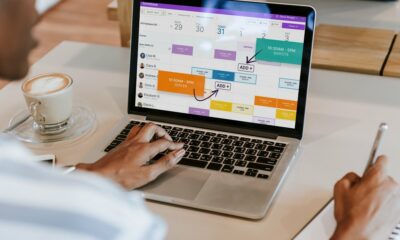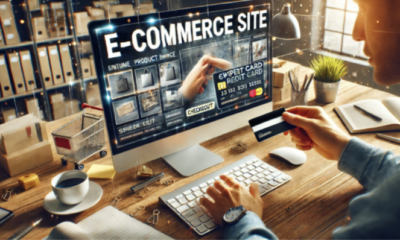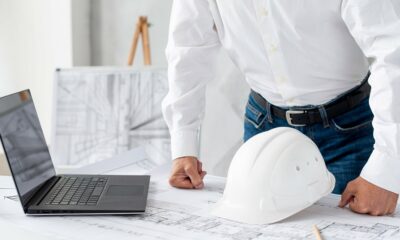MARKETING
How to Leverage Social Media for Your E-commerce Business

You’re probably in a competitive market if you sell fashion accessories, premium gadgets, or consumer-packaged products.
With competitors, consumers, and cultural trends shifting quickly, it can be tough to gain a competitive advantage – and even more difficult to maintain. Fortunately, an effective technique to stake an e-commerce claim allows you to move quickly and organically engage with customers to increase sales and conversions.
Even better, it is most likely that you already have one foot in the door using this instrument, which is social commerce.
Why is Social Commerce Important for E-commerce Businesses?
Social commerce is selling products or services directly through social media platforms. It differs from traditional e-commerce because customers can discover and purchase products directly within their social media feeds. It often involves more user-generated content and personalized shopping experiences. Social commerce provides businesses with an additional avenue for reaching customers and increasing sales and engagement.
The following are the benefits of social commerce for e-commerce businesses:
- Increased visibility and brand awareness: Social media platforms give businesses a wider and more engaged audience to showcase their products, increase visibility, and build brand awareness.
- Higher conversion rates: Social commerce enables customers to browse and purchase products directly from social media platforms, streamlining the buying process and increasing business conversion rates.
- Improved customer engagement: Social media platforms allow businesses to interact directly with customers, answer questions, and respond to feedback. This interaction can help businesses build stronger relationships with their customers and improve customer satisfaction.
- Cost-effective marketing: Social media platforms offer cost-effective marketing opportunities for businesses of all sizes, allowing them to reach a large audience without breaking the bank.
- Increased sales: By leveraging social commerce, businesses can tap into the power of social media to boost their online sales and grow their customer base.
- Competitive advantage: Social commerce is still a relatively new concept, and businesses that adopt it early can gain a competitive advantage over their competitors.
How to Utilize Social Media for Your E-Commerce Business

Utilizing social media for your e-commerce business can be a highly effective way to increase brand awareness, drive traffic to your website, and boost sales. Here are some tips on how to make the most of social media for your e-commerce business:
1. Choose the right social media platform: Identify the target audience and the social media platforms they are most active on. Then, create a presence on those tailor-made platforms for the audience.
2. Create a social media strategy: Define the social media goals, target audience, content strategy, and posting frequency. Ensure that the content strategy showcases products and provides value to the audience.
3. Build a social media presence and engage with the audience: Respond promptly to comments and messages, and encourage user-generated content. This helps build a loyal customer base and increases engagement.
4. Drive traffic and sales to the e-commerce website: Create shoppable posts, use product tagging, and promote sales and discounts to drive traffic and sales to the e-commerce website.
Revolutionizing e-Commerce: Unique Features of Social Commerce Platforms that Help Businesses Grow
Social commerce platforms offer unique features that can help businesses grow and revolutionize the e-commerce industry. Here are some of the most important features that businesses can utilize:
Instagram is a popular social media platform that allows users to share photos and videos. With its shopping feature, businesses can create a shoppable feed of their products, tag products in their posts, and even set up an Instagram shop where customers can browse and purchase directly from their profile.
Facebook Shops
Facebook Shops is a feature that allows businesses to set up an online store on their Facebook page. With Facebook Shops, businesses can showcase their products, customize their storefront, and communicate with customers through Facebook Messenger.
Pinterest is a visual search engine where users can discover and save ideas for projects, products, and more. Businesses can create pins and boards showcasing their products, and users can save and share them with others. Pinterest also has a shopping feature that allows businesses to tag products in their pins and create shoppable pins.
TikTok
TikTok is a popular short-form video app that has become a powerful marketing tool for businesses. With TikTok’s “Shop Now” feature, businesses can link to their online store directly from their videos, making it easy for viewers to shop for their products. You can also use TikTok analytics tools to get more insights.
Snapchat
Snapchat is a social media platform that allows users to share photos and videos that disappear after a short period of time. With its shoppable AR lenses, businesses can create fun, interactive experiences that allow users to try on products virtually and purchase them directly from the app.
Each social commerce platform has unique features that can help businesses grow by reaching new customers, increasing engagement, and driving sales.
Tips for Successful Social Commerce Implementation
Successful implementation of social commerce requires a well-thought-out strategy and execution plan. Here are some tips to help ensure success:
1. Best Practices for Incorporating Social Commerce into your e-Commerce Business
- Choose the right social media platforms: Research the platforms your target audience uses most frequently and focus your efforts on those channels.
- Optimize your social media profiles: Make sure your social media profiles are complete and consistent with your brand image. Use high-quality images, engaging descriptions, and links to your e-commerce site.
- Create engaging content: Utilize visually appealing images and videos to showcase your products and promote special offers and promotions. Engaging content can help capture the attention of your audience and increase engagement.
- Make it easy to purchase: Ensure that customers can easily find and purchase your products from your social media profiles. Use social commerce tools such as “Shop Now” buttons, shoppable posts, and in-app checkout features. Look for apps that help deliver an excellent customer experience.
- Provide excellent customer service: Respond promptly to customer inquiries and feedback on social media. Use social media to build relationships with customers and address any concerns.
2. How to Measure the Success of your Social Commerce Efforts
- Track social media metrics: Monitor engagement metrics such as likes, shares, comments, click-through rates, and lead conversion rates to gauge the effectiveness of your social commerce efforts.
- Measure sales: Keep track of the number of sales generated from social media channels to determine the impact of social commerce on your e-commerce business.
- Analyze customer feedback: Monitor customer feedback on social media to identify areas for improvement and gain insights into customer preferences and needs.
- Conduct surveys: Use surveys to gather feedback from customers on their social commerce experience and identify ways to improve it.
3. Common Pitfalls to Avoid when Implementing Social Commerce
- Neglecting customer service: Failing to respond to customer inquiries and feedback can damage your reputation and hinder your social commerce efforts.
- Focusing solely on sales: Avoid using social media as a sales platform. Instead, focus on building relationships with customers and creating a positive user experience.
- Ignoring data: Monitor and analyze social media metrics to identify areas for improvement and adjust your social commerce strategy accordingly.
Conclusion
Social media has changed the game for e-commerce businesses with the rise of social commerce. By integrating social media platforms with e-commerce, businesses can tap into the power of social media to boost sales, improve customer engagement, and gain a competitive advantage.
To succeed in social commerce, businesses should choose the right platform, create engaging content, and make it easy for customers to purchase their products.
It’s time to revolutionize your e-commerce business with the power of social commerce!
MARKETING
YouTube Ad Specs, Sizes, and Examples [2024 Update]
![YouTube Ad Specs, Sizes, and Examples [2024 Update] YouTube Ad Specs, Sizes, and Examples](https://articles.entireweb.com/wp-content/uploads/2024/06/YouTube-Ad-Specs-Sizes-and-Examples.jpg)
Introduction
With billions of users each month, YouTube is the world’s second largest search engine and top website for video content. This makes it a great place for advertising. To succeed, advertisers need to follow the correct YouTube ad specifications. These rules help your ad reach more viewers, increasing the chance of gaining new customers and boosting brand awareness.
Types of YouTube Ads
Video Ads
- Description: These play before, during, or after a YouTube video on computers or mobile devices.
- Types:
- In-stream ads: Can be skippable or non-skippable.
- Bumper ads: Non-skippable, short ads that play before, during, or after a video.
Display Ads
- Description: These appear in different spots on YouTube and usually use text or static images.
- Note: YouTube does not support display image ads directly on its app, but these can be targeted to YouTube.com through Google Display Network (GDN).
Companion Banners
- Description: Appears to the right of the YouTube player on desktop.
- Requirement: Must be purchased alongside In-stream ads, Bumper ads, or In-feed ads.
In-feed Ads
- Description: Resemble videos with images, headlines, and text. They link to a public or unlisted YouTube video.
Outstream Ads
- Description: Mobile-only video ads that play outside of YouTube, on websites and apps within the Google video partner network.
Masthead Ads
- Description: Premium, high-visibility banner ads displayed at the top of the YouTube homepage for both desktop and mobile users.
YouTube Ad Specs by Type
Skippable In-stream Video Ads
- Placement: Before, during, or after a YouTube video.
- Resolution:
- Horizontal: 1920 x 1080px
- Vertical: 1080 x 1920px
- Square: 1080 x 1080px
- Aspect Ratio:
- Horizontal: 16:9
- Vertical: 9:16
- Square: 1:1
- Length:
- Awareness: 15-20 seconds
- Consideration: 2-3 minutes
- Action: 15-20 seconds
Non-skippable In-stream Video Ads
- Description: Must be watched completely before the main video.
- Length: 15 seconds (or 20 seconds in certain markets).
- Resolution:
- Horizontal: 1920 x 1080px
- Vertical: 1080 x 1920px
- Square: 1080 x 1080px
- Aspect Ratio:
- Horizontal: 16:9
- Vertical: 9:16
- Square: 1:1
Bumper Ads
- Length: Maximum 6 seconds.
- File Format: MP4, Quicktime, AVI, ASF, Windows Media, or MPEG.
- Resolution:
- Horizontal: 640 x 360px
- Vertical: 480 x 360px
In-feed Ads
- Description: Show alongside YouTube content, like search results or the Home feed.
- Resolution:
- Horizontal: 1920 x 1080px
- Vertical: 1080 x 1920px
- Square: 1080 x 1080px
- Aspect Ratio:
- Horizontal: 16:9
- Square: 1:1
- Length:
- Awareness: 15-20 seconds
- Consideration: 2-3 minutes
- Headline/Description:
- Headline: Up to 2 lines, 40 characters per line
- Description: Up to 2 lines, 35 characters per line
Display Ads
- Description: Static images or animated media that appear on YouTube next to video suggestions, in search results, or on the homepage.
- Image Size: 300×60 pixels.
- File Type: GIF, JPG, PNG.
- File Size: Max 150KB.
- Max Animation Length: 30 seconds.
Outstream Ads
- Description: Mobile-only video ads that appear on websites and apps within the Google video partner network, not on YouTube itself.
- Logo Specs:
- Square: 1:1 (200 x 200px).
- File Type: JPG, GIF, PNG.
- Max Size: 200KB.
Masthead Ads
- Description: High-visibility ads at the top of the YouTube homepage.
- Resolution: 1920 x 1080 or higher.
- File Type: JPG or PNG (without transparency).
Conclusion
YouTube offers a variety of ad formats to reach audiences effectively in 2024. Whether you want to build brand awareness, drive conversions, or target specific demographics, YouTube provides a dynamic platform for your advertising needs. Always follow Google’s advertising policies and the technical ad specs to ensure your ads perform their best. Ready to start using YouTube ads? Contact us today to get started!
MARKETING
Why We Are Always ‘Clicking to Buy’, According to Psychologists

Amazon pillows.
MARKETING
A deeper dive into data, personalization and Copilots

Salesforce launched a collection of new, generative AI-related products at Connections in Chicago this week. They included new Einstein Copilots for marketers and merchants and Einstein Personalization.
To better understand, not only the potential impact of the new products, but the evolving Salesforce architecture, we sat down with Bobby Jania, CMO, Marketing Cloud.
Dig deeper: Salesforce piles on the Einstein Copilots
Salesforce’s evolving architecture
It’s hard to deny that Salesforce likes coming up with new names for platforms and products (what happened to Customer 360?) and this can sometimes make the observer wonder if something is brand new, or old but with a brand new name. In particular, what exactly is Einstein 1 and how is it related to Salesforce Data Cloud?
“Data Cloud is built on the Einstein 1 platform,” Jania explained. “The Einstein 1 platform is our entire Salesforce platform and that includes products like Sales Cloud, Service Cloud — that it includes the original idea of Salesforce not just being in the cloud, but being multi-tenancy.”
Data Cloud — not an acquisition, of course — was built natively on that platform. It was the first product built on Hyperforce, Salesforce’s new cloud infrastructure architecture. “Since Data Cloud was on what we now call the Einstein 1 platform from Day One, it has always natively connected to, and been able to read anything in Sales Cloud, Service Cloud [and so on]. On top of that, we can now bring in, not only structured but unstructured data.”
That’s a significant progression from the position, several years ago, when Salesforce had stitched together a platform around various acquisitions (ExactTarget, for example) that didn’t necessarily talk to each other.
“At times, what we would do is have a kind of behind-the-scenes flow where data from one product could be moved into another product,” said Jania, “but in many of those cases the data would then be in both, whereas now the data is in Data Cloud. Tableau will run natively off Data Cloud; Commerce Cloud, Service Cloud, Marketing Cloud — they’re all going to the same operational customer profile.” They’re not copying the data from Data Cloud, Jania confirmed.
Another thing to know is tit’s possible for Salesforce customers to import their own datasets into Data Cloud. “We wanted to create a federated data model,” said Jania. “If you’re using Snowflake, for example, we more or less virtually sit on your data lake. The value we add is that we will look at all your data and help you form these operational customer profiles.”
Let’s learn more about Einstein Copilot
“Copilot means that I have an assistant with me in the tool where I need to be working that contextually knows what I am trying to do and helps me at every step of the process,” Jania said.
For marketers, this might begin with a campaign brief developed with Copilot’s assistance, the identification of an audience based on the brief, and then the development of email or other content. “What’s really cool is the idea of Einstein Studio where our customers will create actions [for Copilot] that we hadn’t even thought about.”
Here’s a key insight (back to nomenclature). We reported on Copilot for markets, Copilot for merchants, Copilot for shoppers. It turns out, however, that there is just one Copilot, Einstein Copilot, and these are use cases. “There’s just one Copilot, we just add these for a little clarity; we’re going to talk about marketing use cases, about shoppers’ use cases. These are actions for the marketing use cases we built out of the box; you can build your own.”
It’s surely going to take a little time for marketers to learn to work easily with Copilot. “There’s always time for adoption,” Jania agreed. “What is directly connected with this is, this is my ninth Connections and this one has the most hands-on training that I’ve seen since 2014 — and a lot of that is getting people using Data Cloud, using these tools rather than just being given a demo.”
What’s new about Einstein Personalization
Salesforce Einstein has been around since 2016 and many of the use cases seem to have involved personalization in various forms. What’s new?
“Einstein Personalization is a real-time decision engine and it’s going to choose next-best-action, next-best-offer. What is new is that it’s a service now that runs natively on top of Data Cloud.” A lot of real-time decision engines need their own set of data that might actually be a subset of data. “Einstein Personalization is going to look holistically at a customer and recommend a next-best-action that could be natively surfaced in Service Cloud, Sales Cloud or Marketing Cloud.”
Finally, trust
One feature of the presentations at Connections was the reassurance that, although public LLMs like ChatGPT could be selected for application to customer data, none of that data would be retained by the LLMs. Is this just a matter of written agreements? No, not just that, said Jania.
“In the Einstein Trust Layer, all of the data, when it connects to an LLM, runs through our gateway. If there was a prompt that had personally identifiable information — a credit card number, an email address — at a mimum, all that is stripped out. The LLMs do not store the output; we store the output for auditing back in Salesforce. Any output that comes back through our gateway is logged in our system; it runs through a toxicity model; and only at the end do we put PII data back into the answer. There are real pieces beyond a handshake that this data is safe.”
-

 SEO7 days ago
SEO7 days agoGoogle’s Revamped Documentation Shows 4 Reasons To Refresh Content
-
SEARCHENGINES5 days ago
Daily Search Forum Recap: August 26, 2024
-

 SEARCHENGINES7 days ago
SEARCHENGINES7 days agoGoogle Ranking Bug Fixed, August Core Update Swings, AI Overviews, Google Ads Bug & More
-

 WORDPRESS7 days ago
WORDPRESS7 days agoHow to Secure Your WordPress Store
-
SEARCHENGINES4 days ago
Daily Search Forum Recap: August 27, 2024
-

 AFFILIATE MARKETING7 days ago
AFFILIATE MARKETING7 days agoBusiness Owners are Batting 1,000 With This All-in-One Management Hub
-

 SEARCHENGINES6 days ago
SEARCHENGINES6 days agoGoogle Migrating All To Google Merchant Center Next By September
-

 WORDPRESS5 days ago
WORDPRESS5 days ago10 Best StudioPress Alternatives (Genesis Framework)














